Ethical and Legal Issues in Medical Healthcare: Case Study
VerifiedAdded on 2023/06/05
|11
|4403
|412
Case Study
AI Summary
This case study analyzes the ethical and legal issues surrounding the medical care of Jo, a 46-year-old woman presenting with upper abdominal pain at a rural emergency department. The assignment examines the actions of the nurse and doctor, highlighting instances where ethical principles such as beneficence, non-maleficence, and autonomy were either upheld or potentially violated. It explores the duty of care, triage processes, and the challenges faced due to staff shortages, as well as the ethical dilemmas encountered during the endoscopy procedure. The case study emphasizes the importance of adhering to ethical codes and legal guidelines in nursing practice, including informed consent and the provision of quality care. The analysis considers the application of ethical theories and principles, legal aspects, and assessment, analysis, and intervention skills within the context of Jo's treatment, ultimately aiming to provide insights into the complex ethical landscape of medical healthcare.
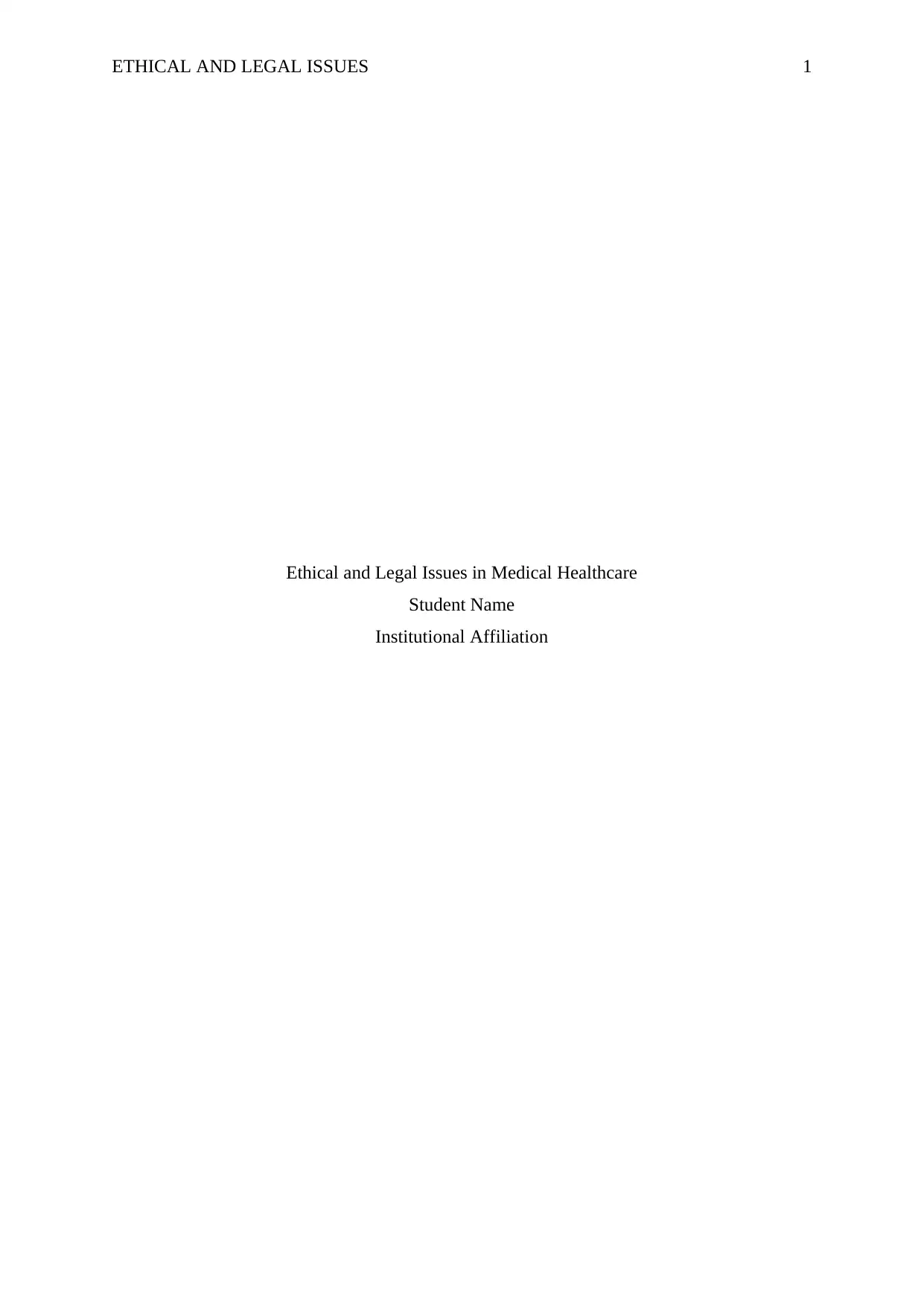
ETHICAL AND LEGAL ISSUES 1
Ethical and Legal Issues in Medical Healthcare
Student Name
Institutional Affiliation
Ethical and Legal Issues in Medical Healthcare
Student Name
Institutional Affiliation
Paraphrase This Document
Need a fresh take? Get an instant paraphrase of this document with our AI Paraphraser

2
There are numerous dynamics that affect a patient’s health care outcomes. Nurses and
doctors should be aware of these factors all the times while assessing a patient’s condition.
These factors include ethical theories and principles, legal aspects, assessment, analysis and
intervention skills, reasoning skills and the general knowledge of medicine. Nurses should
also be able to relate well with patients as well as possess quality communication skills
(Bramhall, 2014). This case study seeks to outline the necessary ethical and legal issues
applicable to nursing and medical health care. Ethics involve the integral and competent
aspects of nursing professions. Ethics outline what nurses should do to cure patients, how and
why they should do it (Epstein & Turner, 2015). Nurses need to abide to a specific code of
conduct while administering treatment methods to patients. Laws are the rules that bind
together people in a society, organization or certain professions. There are several rules and
regulations that guide nurses in professional organizations (Barloon & Hilliard, 2016). There
are some activities, if carried out by nurses, are considered to be illegal. Therefore nurses
need to ensure that they adhere to the legal guidelines at their disposal. Illegal acts in the
nursing profession definitely attract penalties such as imprisonment. Nurses should ensure
that every activity that they undertake while treating patients is cognizant with the ethical and
legal aspects of nursing profession. In this case study a medical issue regarding Jo, a 46 year
old woman with upper abdominal pains, was presented at the rural accident and emergency
department with her partner. Therefore an assessment relating to ethics and law within the
nursing profession is the main focus of this assignment.
Jo, a 46year old female, presented herself to the emergency department complaining
of upper abdominal pain. Jo was firstly triaged by the registered nurse and her vital signs and
pain score were noted. Jo’s temperature was 37.2, pulse 96, respiration 16, BP 136/86 and her
pain score was six. Jo had also experienced nausea and abdominal bloating. Jo had also been
taking Mylanta for the indigestion in the past year. She had a urine sample tested by the
registered nurse and this had no abnormalities therefore the nurse requested the doctor’s
immediate attention. However, the doctor had to attend to an accident victim therefore wasn’t
able to attend to Jo immediately. Jo vomited dark coffee ground fluid two hours after her
admission to the emergency department. Her pulse was rising and her blood pressure falling.
Jo was assessed by a more senior doctor who inserted an intravenous line, a full blood count
and group and hold. Jo was prescribed Pethidine 100mg and Maxolon 10mg by the doctor for
her pain and nausea. This pain relief made Jo drowsy and she vomited coffee ground fluid
once again. The nurse monitored Jo’s signs consistently before she was referred to the theatre
for an endoscopy procedure.
There are numerous dynamics that affect a patient’s health care outcomes. Nurses and
doctors should be aware of these factors all the times while assessing a patient’s condition.
These factors include ethical theories and principles, legal aspects, assessment, analysis and
intervention skills, reasoning skills and the general knowledge of medicine. Nurses should
also be able to relate well with patients as well as possess quality communication skills
(Bramhall, 2014). This case study seeks to outline the necessary ethical and legal issues
applicable to nursing and medical health care. Ethics involve the integral and competent
aspects of nursing professions. Ethics outline what nurses should do to cure patients, how and
why they should do it (Epstein & Turner, 2015). Nurses need to abide to a specific code of
conduct while administering treatment methods to patients. Laws are the rules that bind
together people in a society, organization or certain professions. There are several rules and
regulations that guide nurses in professional organizations (Barloon & Hilliard, 2016). There
are some activities, if carried out by nurses, are considered to be illegal. Therefore nurses
need to ensure that they adhere to the legal guidelines at their disposal. Illegal acts in the
nursing profession definitely attract penalties such as imprisonment. Nurses should ensure
that every activity that they undertake while treating patients is cognizant with the ethical and
legal aspects of nursing profession. In this case study a medical issue regarding Jo, a 46 year
old woman with upper abdominal pains, was presented at the rural accident and emergency
department with her partner. Therefore an assessment relating to ethics and law within the
nursing profession is the main focus of this assignment.
Jo, a 46year old female, presented herself to the emergency department complaining
of upper abdominal pain. Jo was firstly triaged by the registered nurse and her vital signs and
pain score were noted. Jo’s temperature was 37.2, pulse 96, respiration 16, BP 136/86 and her
pain score was six. Jo had also experienced nausea and abdominal bloating. Jo had also been
taking Mylanta for the indigestion in the past year. She had a urine sample tested by the
registered nurse and this had no abnormalities therefore the nurse requested the doctor’s
immediate attention. However, the doctor had to attend to an accident victim therefore wasn’t
able to attend to Jo immediately. Jo vomited dark coffee ground fluid two hours after her
admission to the emergency department. Her pulse was rising and her blood pressure falling.
Jo was assessed by a more senior doctor who inserted an intravenous line, a full blood count
and group and hold. Jo was prescribed Pethidine 100mg and Maxolon 10mg by the doctor for
her pain and nausea. This pain relief made Jo drowsy and she vomited coffee ground fluid
once again. The nurse monitored Jo’s signs consistently before she was referred to the theatre
for an endoscopy procedure.
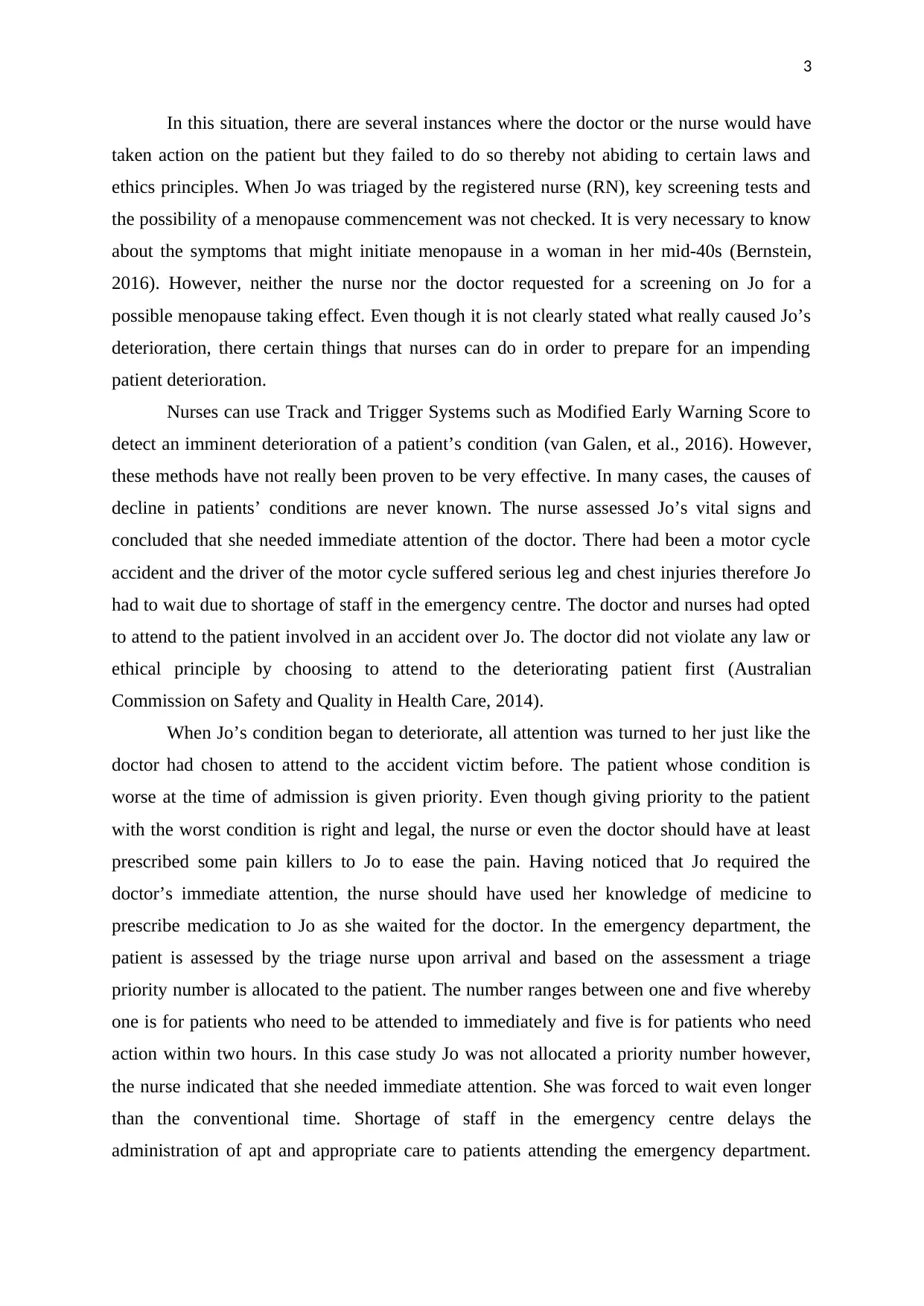
3
In this situation, there are several instances where the doctor or the nurse would have
taken action on the patient but they failed to do so thereby not abiding to certain laws and
ethics principles. When Jo was triaged by the registered nurse (RN), key screening tests and
the possibility of a menopause commencement was not checked. It is very necessary to know
about the symptoms that might initiate menopause in a woman in her mid-40s (Bernstein,
2016). However, neither the nurse nor the doctor requested for a screening on Jo for a
possible menopause taking effect. Even though it is not clearly stated what really caused Jo’s
deterioration, there certain things that nurses can do in order to prepare for an impending
patient deterioration.
Nurses can use Track and Trigger Systems such as Modified Early Warning Score to
detect an imminent deterioration of a patient’s condition (van Galen, et al., 2016). However,
these methods have not really been proven to be very effective. In many cases, the causes of
decline in patients’ conditions are never known. The nurse assessed Jo’s vital signs and
concluded that she needed immediate attention of the doctor. There had been a motor cycle
accident and the driver of the motor cycle suffered serious leg and chest injuries therefore Jo
had to wait due to shortage of staff in the emergency centre. The doctor and nurses had opted
to attend to the patient involved in an accident over Jo. The doctor did not violate any law or
ethical principle by choosing to attend to the deteriorating patient first (Australian
Commission on Safety and Quality in Health Care, 2014).
When Jo’s condition began to deteriorate, all attention was turned to her just like the
doctor had chosen to attend to the accident victim before. The patient whose condition is
worse at the time of admission is given priority. Even though giving priority to the patient
with the worst condition is right and legal, the nurse or even the doctor should have at least
prescribed some pain killers to Jo to ease the pain. Having noticed that Jo required the
doctor’s immediate attention, the nurse should have used her knowledge of medicine to
prescribe medication to Jo as she waited for the doctor. In the emergency department, the
patient is assessed by the triage nurse upon arrival and based on the assessment a triage
priority number is allocated to the patient. The number ranges between one and five whereby
one is for patients who need to be attended to immediately and five is for patients who need
action within two hours. In this case study Jo was not allocated a priority number however,
the nurse indicated that she needed immediate attention. She was forced to wait even longer
than the conventional time. Shortage of staff in the emergency centre delays the
administration of apt and appropriate care to patients attending the emergency department.
In this situation, there are several instances where the doctor or the nurse would have
taken action on the patient but they failed to do so thereby not abiding to certain laws and
ethics principles. When Jo was triaged by the registered nurse (RN), key screening tests and
the possibility of a menopause commencement was not checked. It is very necessary to know
about the symptoms that might initiate menopause in a woman in her mid-40s (Bernstein,
2016). However, neither the nurse nor the doctor requested for a screening on Jo for a
possible menopause taking effect. Even though it is not clearly stated what really caused Jo’s
deterioration, there certain things that nurses can do in order to prepare for an impending
patient deterioration.
Nurses can use Track and Trigger Systems such as Modified Early Warning Score to
detect an imminent deterioration of a patient’s condition (van Galen, et al., 2016). However,
these methods have not really been proven to be very effective. In many cases, the causes of
decline in patients’ conditions are never known. The nurse assessed Jo’s vital signs and
concluded that she needed immediate attention of the doctor. There had been a motor cycle
accident and the driver of the motor cycle suffered serious leg and chest injuries therefore Jo
had to wait due to shortage of staff in the emergency centre. The doctor and nurses had opted
to attend to the patient involved in an accident over Jo. The doctor did not violate any law or
ethical principle by choosing to attend to the deteriorating patient first (Australian
Commission on Safety and Quality in Health Care, 2014).
When Jo’s condition began to deteriorate, all attention was turned to her just like the
doctor had chosen to attend to the accident victim before. The patient whose condition is
worse at the time of admission is given priority. Even though giving priority to the patient
with the worst condition is right and legal, the nurse or even the doctor should have at least
prescribed some pain killers to Jo to ease the pain. Having noticed that Jo required the
doctor’s immediate attention, the nurse should have used her knowledge of medicine to
prescribe medication to Jo as she waited for the doctor. In the emergency department, the
patient is assessed by the triage nurse upon arrival and based on the assessment a triage
priority number is allocated to the patient. The number ranges between one and five whereby
one is for patients who need to be attended to immediately and five is for patients who need
action within two hours. In this case study Jo was not allocated a priority number however,
the nurse indicated that she needed immediate attention. She was forced to wait even longer
than the conventional time. Shortage of staff in the emergency centre delays the
administration of apt and appropriate care to patients attending the emergency department.
⊘ This is a preview!⊘
Do you want full access?
Subscribe today to unlock all pages.

Trusted by 1+ million students worldwide

4
Shortage of staff also delays the initiation of interventions and medical care to patients
(Bradley, et al., 2015).
In line with Jo’s case study, an ethical dilemma is evident as the anaesthetist
encountered difficulty maintaining Jo’s saturations in theatre during the endoscopy
procedure. Ethical dilemmas comprise of situations whereby a choice must be made from the
available options that can be justified as the unsurpassed choice considering the situation
(Beauchamp & Childress, 2013). In this situation the anaesthetist has decided to carry on with
the endoscopy procedure despite Jo’s saturations proving to be beyond control. The
anaesthetist perceived that the Jo had vomited at emergency department prior to admission at
the endoscopy department. However, the anaesthetist had an option of checking with the
nurse to confirm about the assessment of the medical situation and need for the endoscopy.
Jo’s vital signs required immediate attention of the doctor. The code of ethics also
obliges nurses to provide high quality care to the patients they handle (Zahedi, et al., 2013).
Even though these codes are obligatory to patients, they guide and support nurses in their
practice of medicine and helps them to avoid moral anguish. The codes also outline the
relationship that nurses should maintain with their patients. In Jo’s situation, it is the nurse’s
and doctor’s duty to provide quality care to the patient. Jo has upper abdominal pain, nausea,
abdominal bloating and a history of indigestion. While assessing the patient the nurse did not
provide a treatment plan for the symptoms evident in Jo.
Autonomy is the ability of nurses to act according to their professional knowledge
while administering clinical care to patients (Kumar & McHugh, 2017). However, autonomy
does not just apply to nurses. It is the ability to make informed decisions therefore patients
can also find themselves in a position whereby they have to make a decision. The patients are
accorded the freedom of consent which enables them to make decisions during emergency
situations. Both Jo and the doctor exercised their autonomy in this situation. When Jo was
taken to the theatre for an endoscopy procedure, she had to consent before the emergency
procedure was carried out on her (Staunton & Chiarella, 2016). The doctor used the
professional knowledge of medicine to prescribe Pethidine 100mg and Maxolon 10mg to Jo
after looking at the vital signs and symptoms. This is definitely an exercise of autonomy.
Beneficence refers to the act of doing a good thing and its main intention is to carry
out affirmative actions to patients. It proclaims an obligation to physicians of helping
patients. In this case study, the nurse monitored Jo’s vital signs consistently. This is an act of
benevolence since the patient’s deterioration is preceded by changes in vital signs.
Monitoring the patient’s vital signs consistently helps in detecting an impending clinical
Shortage of staff also delays the initiation of interventions and medical care to patients
(Bradley, et al., 2015).
In line with Jo’s case study, an ethical dilemma is evident as the anaesthetist
encountered difficulty maintaining Jo’s saturations in theatre during the endoscopy
procedure. Ethical dilemmas comprise of situations whereby a choice must be made from the
available options that can be justified as the unsurpassed choice considering the situation
(Beauchamp & Childress, 2013). In this situation the anaesthetist has decided to carry on with
the endoscopy procedure despite Jo’s saturations proving to be beyond control. The
anaesthetist perceived that the Jo had vomited at emergency department prior to admission at
the endoscopy department. However, the anaesthetist had an option of checking with the
nurse to confirm about the assessment of the medical situation and need for the endoscopy.
Jo’s vital signs required immediate attention of the doctor. The code of ethics also
obliges nurses to provide high quality care to the patients they handle (Zahedi, et al., 2013).
Even though these codes are obligatory to patients, they guide and support nurses in their
practice of medicine and helps them to avoid moral anguish. The codes also outline the
relationship that nurses should maintain with their patients. In Jo’s situation, it is the nurse’s
and doctor’s duty to provide quality care to the patient. Jo has upper abdominal pain, nausea,
abdominal bloating and a history of indigestion. While assessing the patient the nurse did not
provide a treatment plan for the symptoms evident in Jo.
Autonomy is the ability of nurses to act according to their professional knowledge
while administering clinical care to patients (Kumar & McHugh, 2017). However, autonomy
does not just apply to nurses. It is the ability to make informed decisions therefore patients
can also find themselves in a position whereby they have to make a decision. The patients are
accorded the freedom of consent which enables them to make decisions during emergency
situations. Both Jo and the doctor exercised their autonomy in this situation. When Jo was
taken to the theatre for an endoscopy procedure, she had to consent before the emergency
procedure was carried out on her (Staunton & Chiarella, 2016). The doctor used the
professional knowledge of medicine to prescribe Pethidine 100mg and Maxolon 10mg to Jo
after looking at the vital signs and symptoms. This is definitely an exercise of autonomy.
Beneficence refers to the act of doing a good thing and its main intention is to carry
out affirmative actions to patients. It proclaims an obligation to physicians of helping
patients. In this case study, the nurse monitored Jo’s vital signs consistently. This is an act of
benevolence since the patient’s deterioration is preceded by changes in vital signs.
Monitoring the patient’s vital signs consistently helps in detecting an impending clinical
Paraphrase This Document
Need a fresh take? Get an instant paraphrase of this document with our AI Paraphraser
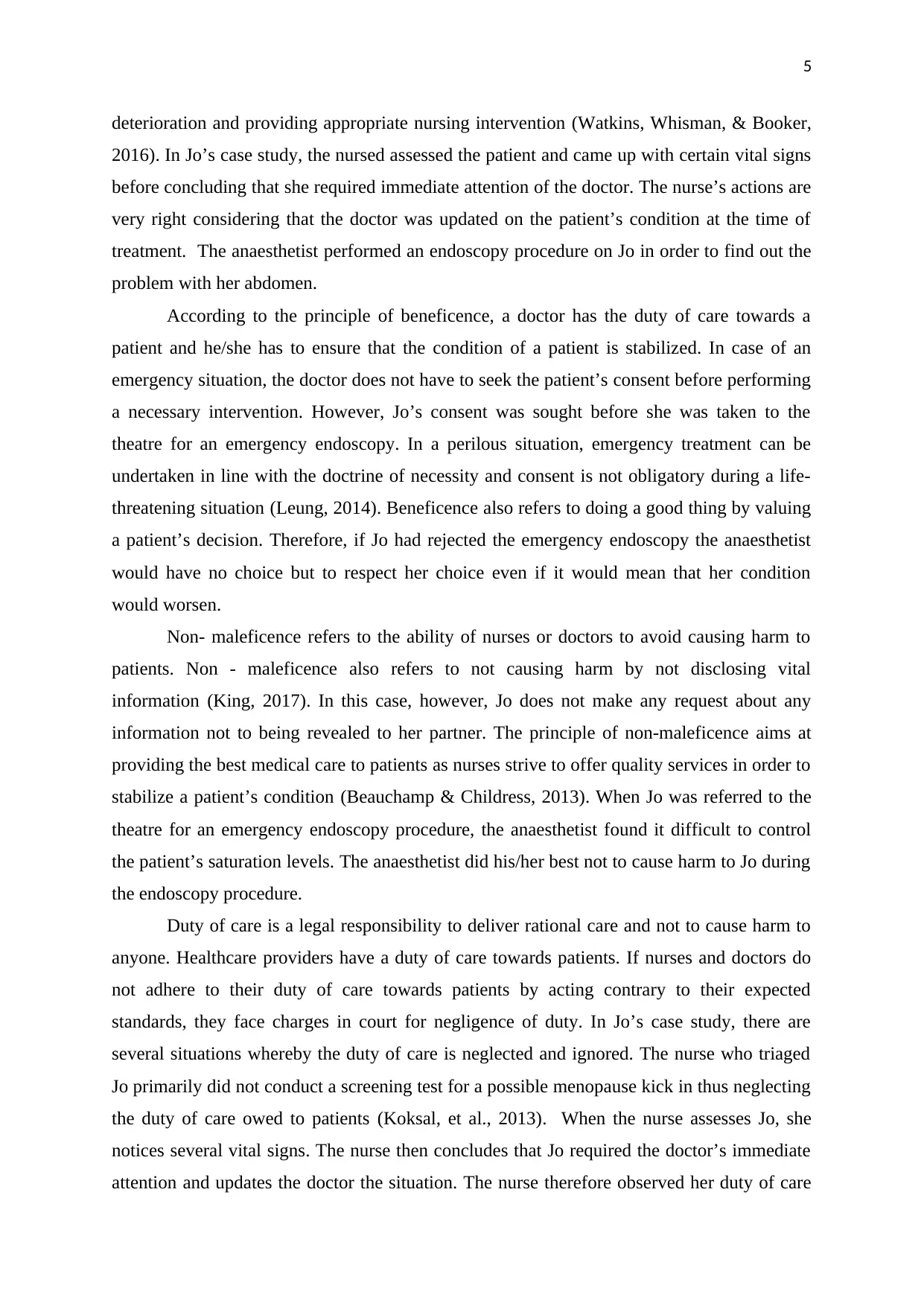
5
deterioration and providing appropriate nursing intervention (Watkins, Whisman, & Booker,
2016). In Jo’s case study, the nursed assessed the patient and came up with certain vital signs
before concluding that she required immediate attention of the doctor. The nurse’s actions are
very right considering that the doctor was updated on the patient’s condition at the time of
treatment. The anaesthetist performed an endoscopy procedure on Jo in order to find out the
problem with her abdomen.
According to the principle of beneficence, a doctor has the duty of care towards a
patient and he/she has to ensure that the condition of a patient is stabilized. In case of an
emergency situation, the doctor does not have to seek the patient’s consent before performing
a necessary intervention. However, Jo’s consent was sought before she was taken to the
theatre for an emergency endoscopy. In a perilous situation, emergency treatment can be
undertaken in line with the doctrine of necessity and consent is not obligatory during a life-
threatening situation (Leung, 2014). Beneficence also refers to doing a good thing by valuing
a patient’s decision. Therefore, if Jo had rejected the emergency endoscopy the anaesthetist
would have no choice but to respect her choice even if it would mean that her condition
would worsen.
Non- maleficence refers to the ability of nurses or doctors to avoid causing harm to
patients. Non - maleficence also refers to not causing harm by not disclosing vital
information (King, 2017). In this case, however, Jo does not make any request about any
information not to being revealed to her partner. The principle of non-maleficence aims at
providing the best medical care to patients as nurses strive to offer quality services in order to
stabilize a patient’s condition (Beauchamp & Childress, 2013). When Jo was referred to the
theatre for an emergency endoscopy procedure, the anaesthetist found it difficult to control
the patient’s saturation levels. The anaesthetist did his/her best not to cause harm to Jo during
the endoscopy procedure.
Duty of care is a legal responsibility to deliver rational care and not to cause harm to
anyone. Healthcare providers have a duty of care towards patients. If nurses and doctors do
not adhere to their duty of care towards patients by acting contrary to their expected
standards, they face charges in court for negligence of duty. In Jo’s case study, there are
several situations whereby the duty of care is neglected and ignored. The nurse who triaged
Jo primarily did not conduct a screening test for a possible menopause kick in thus neglecting
the duty of care owed to patients (Koksal, et al., 2013). When the nurse assesses Jo, she
notices several vital signs. The nurse then concludes that Jo required the doctor’s immediate
attention and updates the doctor the situation. The nurse therefore observed her duty of care
deterioration and providing appropriate nursing intervention (Watkins, Whisman, & Booker,
2016). In Jo’s case study, the nursed assessed the patient and came up with certain vital signs
before concluding that she required immediate attention of the doctor. The nurse’s actions are
very right considering that the doctor was updated on the patient’s condition at the time of
treatment. The anaesthetist performed an endoscopy procedure on Jo in order to find out the
problem with her abdomen.
According to the principle of beneficence, a doctor has the duty of care towards a
patient and he/she has to ensure that the condition of a patient is stabilized. In case of an
emergency situation, the doctor does not have to seek the patient’s consent before performing
a necessary intervention. However, Jo’s consent was sought before she was taken to the
theatre for an emergency endoscopy. In a perilous situation, emergency treatment can be
undertaken in line with the doctrine of necessity and consent is not obligatory during a life-
threatening situation (Leung, 2014). Beneficence also refers to doing a good thing by valuing
a patient’s decision. Therefore, if Jo had rejected the emergency endoscopy the anaesthetist
would have no choice but to respect her choice even if it would mean that her condition
would worsen.
Non- maleficence refers to the ability of nurses or doctors to avoid causing harm to
patients. Non - maleficence also refers to not causing harm by not disclosing vital
information (King, 2017). In this case, however, Jo does not make any request about any
information not to being revealed to her partner. The principle of non-maleficence aims at
providing the best medical care to patients as nurses strive to offer quality services in order to
stabilize a patient’s condition (Beauchamp & Childress, 2013). When Jo was referred to the
theatre for an emergency endoscopy procedure, the anaesthetist found it difficult to control
the patient’s saturation levels. The anaesthetist did his/her best not to cause harm to Jo during
the endoscopy procedure.
Duty of care is a legal responsibility to deliver rational care and not to cause harm to
anyone. Healthcare providers have a duty of care towards patients. If nurses and doctors do
not adhere to their duty of care towards patients by acting contrary to their expected
standards, they face charges in court for negligence of duty. In Jo’s case study, there are
several situations whereby the duty of care is neglected and ignored. The nurse who triaged
Jo primarily did not conduct a screening test for a possible menopause kick in thus neglecting
the duty of care owed to patients (Koksal, et al., 2013). When the nurse assesses Jo, she
notices several vital signs. The nurse then concludes that Jo required the doctor’s immediate
attention and updates the doctor the situation. The nurse therefore observed her duty of care
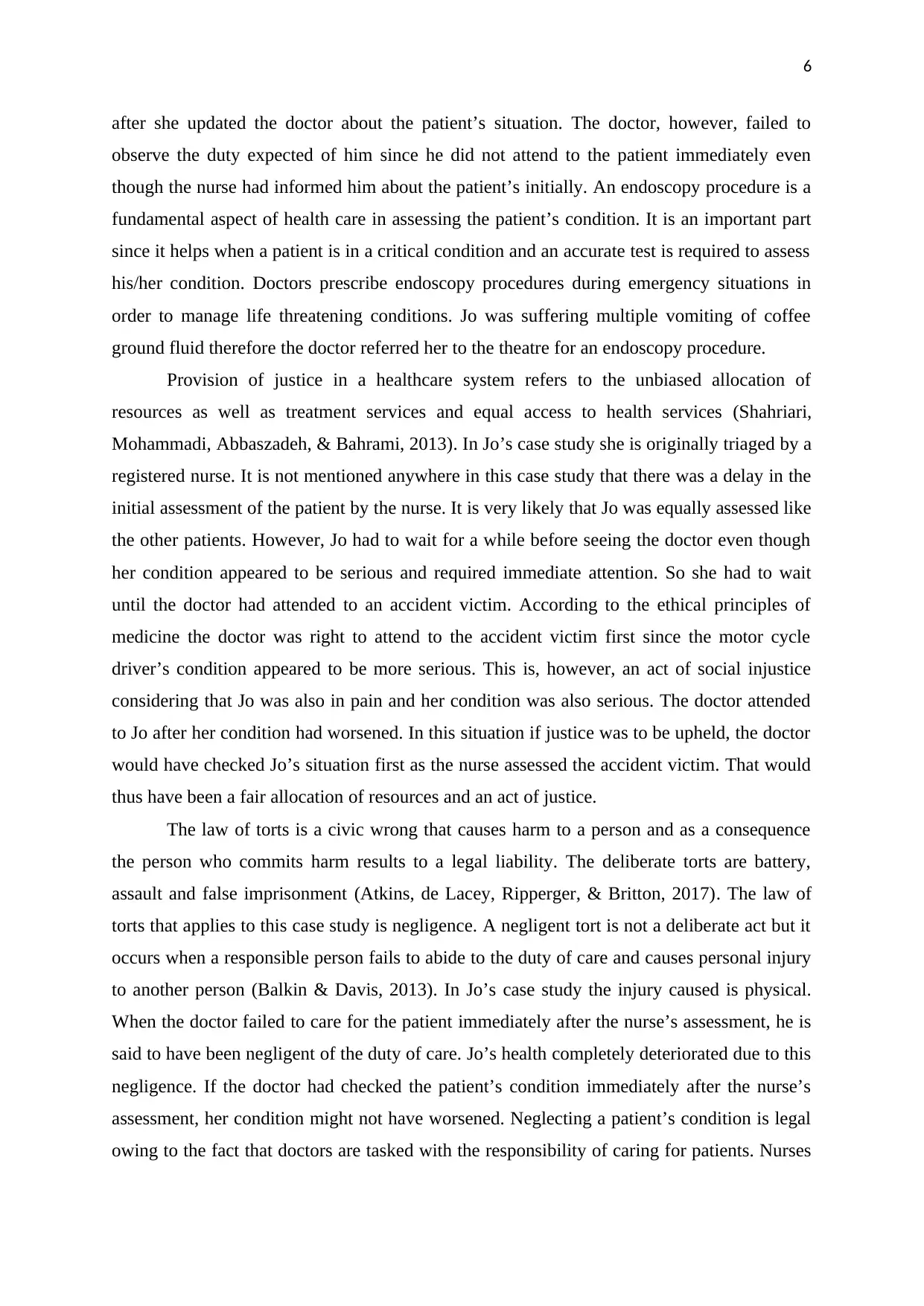
6
after she updated the doctor about the patient’s situation. The doctor, however, failed to
observe the duty expected of him since he did not attend to the patient immediately even
though the nurse had informed him about the patient’s initially. An endoscopy procedure is a
fundamental aspect of health care in assessing the patient’s condition. It is an important part
since it helps when a patient is in a critical condition and an accurate test is required to assess
his/her condition. Doctors prescribe endoscopy procedures during emergency situations in
order to manage life threatening conditions. Jo was suffering multiple vomiting of coffee
ground fluid therefore the doctor referred her to the theatre for an endoscopy procedure.
Provision of justice in a healthcare system refers to the unbiased allocation of
resources as well as treatment services and equal access to health services (Shahriari,
Mohammadi, Abbaszadeh, & Bahrami, 2013). In Jo’s case study she is originally triaged by a
registered nurse. It is not mentioned anywhere in this case study that there was a delay in the
initial assessment of the patient by the nurse. It is very likely that Jo was equally assessed like
the other patients. However, Jo had to wait for a while before seeing the doctor even though
her condition appeared to be serious and required immediate attention. So she had to wait
until the doctor had attended to an accident victim. According to the ethical principles of
medicine the doctor was right to attend to the accident victim first since the motor cycle
driver’s condition appeared to be more serious. This is, however, an act of social injustice
considering that Jo was also in pain and her condition was also serious. The doctor attended
to Jo after her condition had worsened. In this situation if justice was to be upheld, the doctor
would have checked Jo’s situation first as the nurse assessed the accident victim. That would
thus have been a fair allocation of resources and an act of justice.
The law of torts is a civic wrong that causes harm to a person and as a consequence
the person who commits harm results to a legal liability. The deliberate torts are battery,
assault and false imprisonment (Atkins, de Lacey, Ripperger, & Britton, 2017). The law of
torts that applies to this case study is negligence. A negligent tort is not a deliberate act but it
occurs when a responsible person fails to abide to the duty of care and causes personal injury
to another person (Balkin & Davis, 2013). In Jo’s case study the injury caused is physical.
When the doctor failed to care for the patient immediately after the nurse’s assessment, he is
said to have been negligent of the duty of care. Jo’s health completely deteriorated due to this
negligence. If the doctor had checked the patient’s condition immediately after the nurse’s
assessment, her condition might not have worsened. Neglecting a patient’s condition is legal
owing to the fact that doctors are tasked with the responsibility of caring for patients. Nurses
after she updated the doctor about the patient’s situation. The doctor, however, failed to
observe the duty expected of him since he did not attend to the patient immediately even
though the nurse had informed him about the patient’s initially. An endoscopy procedure is a
fundamental aspect of health care in assessing the patient’s condition. It is an important part
since it helps when a patient is in a critical condition and an accurate test is required to assess
his/her condition. Doctors prescribe endoscopy procedures during emergency situations in
order to manage life threatening conditions. Jo was suffering multiple vomiting of coffee
ground fluid therefore the doctor referred her to the theatre for an endoscopy procedure.
Provision of justice in a healthcare system refers to the unbiased allocation of
resources as well as treatment services and equal access to health services (Shahriari,
Mohammadi, Abbaszadeh, & Bahrami, 2013). In Jo’s case study she is originally triaged by a
registered nurse. It is not mentioned anywhere in this case study that there was a delay in the
initial assessment of the patient by the nurse. It is very likely that Jo was equally assessed like
the other patients. However, Jo had to wait for a while before seeing the doctor even though
her condition appeared to be serious and required immediate attention. So she had to wait
until the doctor had attended to an accident victim. According to the ethical principles of
medicine the doctor was right to attend to the accident victim first since the motor cycle
driver’s condition appeared to be more serious. This is, however, an act of social injustice
considering that Jo was also in pain and her condition was also serious. The doctor attended
to Jo after her condition had worsened. In this situation if justice was to be upheld, the doctor
would have checked Jo’s situation first as the nurse assessed the accident victim. That would
thus have been a fair allocation of resources and an act of justice.
The law of torts is a civic wrong that causes harm to a person and as a consequence
the person who commits harm results to a legal liability. The deliberate torts are battery,
assault and false imprisonment (Atkins, de Lacey, Ripperger, & Britton, 2017). The law of
torts that applies to this case study is negligence. A negligent tort is not a deliberate act but it
occurs when a responsible person fails to abide to the duty of care and causes personal injury
to another person (Balkin & Davis, 2013). In Jo’s case study the injury caused is physical.
When the doctor failed to care for the patient immediately after the nurse’s assessment, he is
said to have been negligent of the duty of care. Jo’s health completely deteriorated due to this
negligence. If the doctor had checked the patient’s condition immediately after the nurse’s
assessment, her condition might not have worsened. Neglecting a patient’s condition is legal
owing to the fact that doctors are tasked with the responsibility of caring for patients. Nurses
⊘ This is a preview!⊘
Do you want full access?
Subscribe today to unlock all pages.

Trusted by 1+ million students worldwide

7
and doctors are thus required to use all the resources at their disposal to ensure that patients
are treated appropriately.
There are two major approaches regarding ethics and law that are applicable in his
case study, for instance, utilitarian and deontological approaches. Utilitarianism refers to a
general outcome that brings happiness to the party concerned. In the utilitarian approach, the
outcomes determine and justify the means and greatest benefit expected for the greatest
number and the morality of the intervention (Mandal, Ponnambath, & Parija, 2016). This
approach has its full focus and attention on the society as a whole. The decisions made by a
doctor have to be to the superlative interest of the patient. In this case study the doctor
prescribed Pethidine 100mg and Maxolon 10mg to Jo in order to reduce her pain and nausea.
Despite the fact that the patient became drowsy and vomited coffee ground fluid again, her
pain was relieved. A little bit of harm was caused even though the outcome of the intended
outcome of the intervention was pain relief.
Doctors should always ensure that they maximise the good and limit the harm when
prescribing medication to patients (Johnstone, 2016). On the other hand, the deontological
approach gives priority to the duty and obligations of doctors and the morality of their
actions. The outcome does not justify the means in this approach and whatever the
consequences of a doctor’s decision, harm is totally intolerable (Mandal, Ponnambath, &
Parija, 2016). The doctor and nurses are bound by duty and obligations the happiness of the
greater good is not given priority. In Jo’s case study there happens to be instances where duty
was neglected. The nurse should have screened Jo for a possible menopause commencement
owing to the fact that the patient is in her mid-40s.
Female within the age bracket of 40 – 50 are more likely to be in the menopause stage
therefore Jo should have been screened. Jo’s pain score appeared to be 6 and the nurse
considered that she needed immediate attention of the doctor. However, the doctor opted to
attend to an accident victim first. This caused deterioration of the patient’s condition. Leaving
a patient suffering from pain just to attend to another is unethical according to the medical
ethics. Jo’s assessment already indicated that she needed immediate medical attention
therefore the doctor had no reasons whatsoever to leave Jo in order to attend to the accident
victim. Both seemed to have been serious cases, however, Jo was brought to the emergency
department first. Both patients should have been given immediate medical attention in order
to avoid dire conquers as witnessed in Jo’s situation. Therefore the nurse and doctor
neglected their duty of care to patients with serious conditions.
and doctors are thus required to use all the resources at their disposal to ensure that patients
are treated appropriately.
There are two major approaches regarding ethics and law that are applicable in his
case study, for instance, utilitarian and deontological approaches. Utilitarianism refers to a
general outcome that brings happiness to the party concerned. In the utilitarian approach, the
outcomes determine and justify the means and greatest benefit expected for the greatest
number and the morality of the intervention (Mandal, Ponnambath, & Parija, 2016). This
approach has its full focus and attention on the society as a whole. The decisions made by a
doctor have to be to the superlative interest of the patient. In this case study the doctor
prescribed Pethidine 100mg and Maxolon 10mg to Jo in order to reduce her pain and nausea.
Despite the fact that the patient became drowsy and vomited coffee ground fluid again, her
pain was relieved. A little bit of harm was caused even though the outcome of the intended
outcome of the intervention was pain relief.
Doctors should always ensure that they maximise the good and limit the harm when
prescribing medication to patients (Johnstone, 2016). On the other hand, the deontological
approach gives priority to the duty and obligations of doctors and the morality of their
actions. The outcome does not justify the means in this approach and whatever the
consequences of a doctor’s decision, harm is totally intolerable (Mandal, Ponnambath, &
Parija, 2016). The doctor and nurses are bound by duty and obligations the happiness of the
greater good is not given priority. In Jo’s case study there happens to be instances where duty
was neglected. The nurse should have screened Jo for a possible menopause commencement
owing to the fact that the patient is in her mid-40s.
Female within the age bracket of 40 – 50 are more likely to be in the menopause stage
therefore Jo should have been screened. Jo’s pain score appeared to be 6 and the nurse
considered that she needed immediate attention of the doctor. However, the doctor opted to
attend to an accident victim first. This caused deterioration of the patient’s condition. Leaving
a patient suffering from pain just to attend to another is unethical according to the medical
ethics. Jo’s assessment already indicated that she needed immediate medical attention
therefore the doctor had no reasons whatsoever to leave Jo in order to attend to the accident
victim. Both seemed to have been serious cases, however, Jo was brought to the emergency
department first. Both patients should have been given immediate medical attention in order
to avoid dire conquers as witnessed in Jo’s situation. Therefore the nurse and doctor
neglected their duty of care to patients with serious conditions.
Paraphrase This Document
Need a fresh take? Get an instant paraphrase of this document with our AI Paraphraser
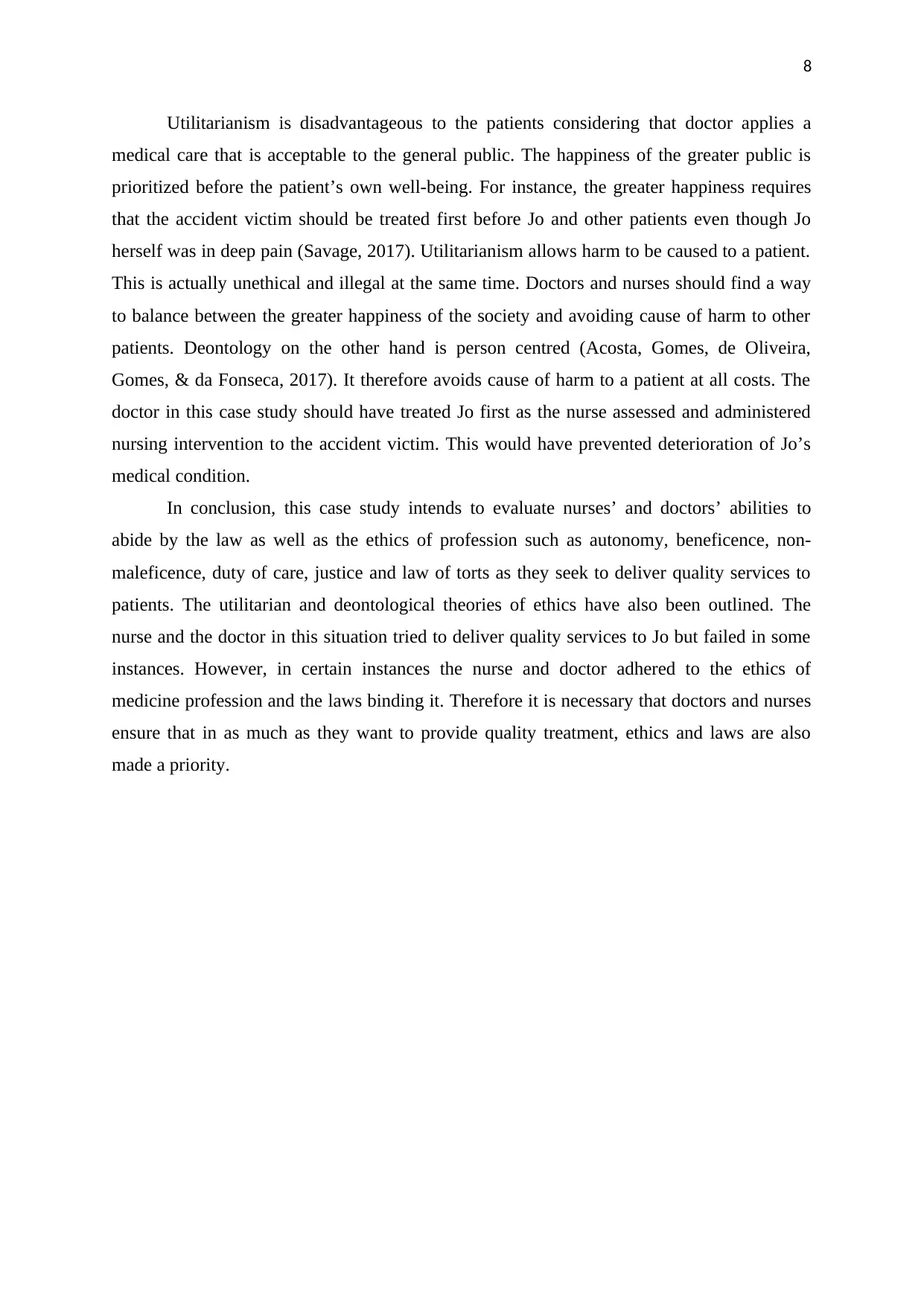
8
Utilitarianism is disadvantageous to the patients considering that doctor applies a
medical care that is acceptable to the general public. The happiness of the greater public is
prioritized before the patient’s own well-being. For instance, the greater happiness requires
that the accident victim should be treated first before Jo and other patients even though Jo
herself was in deep pain (Savage, 2017). Utilitarianism allows harm to be caused to a patient.
This is actually unethical and illegal at the same time. Doctors and nurses should find a way
to balance between the greater happiness of the society and avoiding cause of harm to other
patients. Deontology on the other hand is person centred (Acosta, Gomes, de Oliveira,
Gomes, & da Fonseca, 2017). It therefore avoids cause of harm to a patient at all costs. The
doctor in this case study should have treated Jo first as the nurse assessed and administered
nursing intervention to the accident victim. This would have prevented deterioration of Jo’s
medical condition.
In conclusion, this case study intends to evaluate nurses’ and doctors’ abilities to
abide by the law as well as the ethics of profession such as autonomy, beneficence, non-
maleficence, duty of care, justice and law of torts as they seek to deliver quality services to
patients. The utilitarian and deontological theories of ethics have also been outlined. The
nurse and the doctor in this situation tried to deliver quality services to Jo but failed in some
instances. However, in certain instances the nurse and doctor adhered to the ethics of
medicine profession and the laws binding it. Therefore it is necessary that doctors and nurses
ensure that in as much as they want to provide quality treatment, ethics and laws are also
made a priority.
Utilitarianism is disadvantageous to the patients considering that doctor applies a
medical care that is acceptable to the general public. The happiness of the greater public is
prioritized before the patient’s own well-being. For instance, the greater happiness requires
that the accident victim should be treated first before Jo and other patients even though Jo
herself was in deep pain (Savage, 2017). Utilitarianism allows harm to be caused to a patient.
This is actually unethical and illegal at the same time. Doctors and nurses should find a way
to balance between the greater happiness of the society and avoiding cause of harm to other
patients. Deontology on the other hand is person centred (Acosta, Gomes, de Oliveira,
Gomes, & da Fonseca, 2017). It therefore avoids cause of harm to a patient at all costs. The
doctor in this case study should have treated Jo first as the nurse assessed and administered
nursing intervention to the accident victim. This would have prevented deterioration of Jo’s
medical condition.
In conclusion, this case study intends to evaluate nurses’ and doctors’ abilities to
abide by the law as well as the ethics of profession such as autonomy, beneficence, non-
maleficence, duty of care, justice and law of torts as they seek to deliver quality services to
patients. The utilitarian and deontological theories of ethics have also been outlined. The
nurse and the doctor in this situation tried to deliver quality services to Jo but failed in some
instances. However, in certain instances the nurse and doctor adhered to the ethics of
medicine profession and the laws binding it. Therefore it is necessary that doctors and nurses
ensure that in as much as they want to provide quality treatment, ethics and laws are also
made a priority.
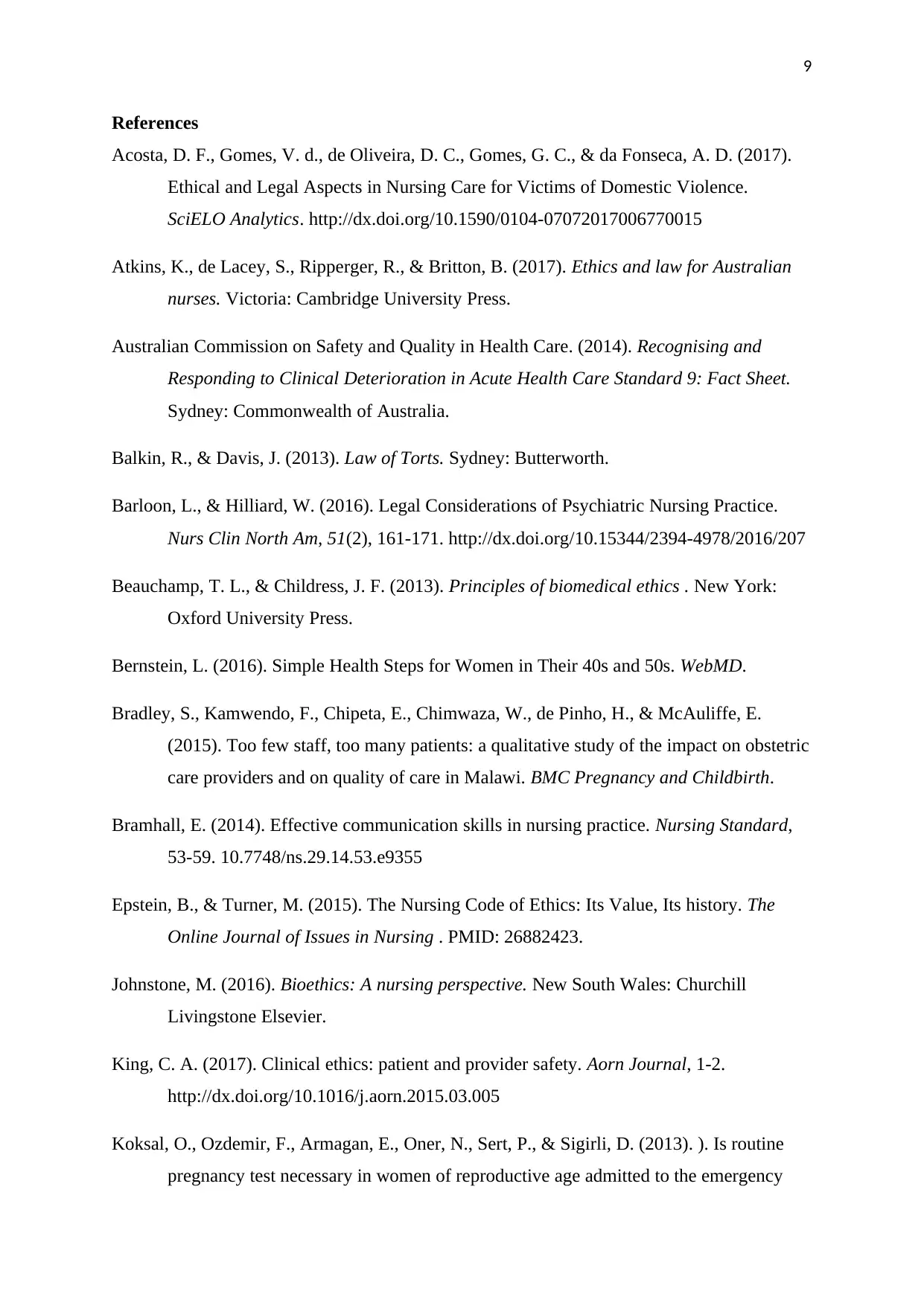
9
References
Acosta, D. F., Gomes, V. d., de Oliveira, D. C., Gomes, G. C., & da Fonseca, A. D. (2017).
Ethical and Legal Aspects in Nursing Care for Victims of Domestic Violence.
SciELO Analytics. http://dx.doi.org/10.1590/0104-07072017006770015
Atkins, K., de Lacey, S., Ripperger, R., & Britton, B. (2017). Ethics and law for Australian
nurses. Victoria: Cambridge University Press.
Australian Commission on Safety and Quality in Health Care. (2014). Recognising and
Responding to Clinical Deterioration in Acute Health Care Standard 9: Fact Sheet.
Sydney: Commonwealth of Australia.
Balkin, R., & Davis, J. (2013). Law of Torts. Sydney: Butterworth.
Barloon, L., & Hilliard, W. (2016). Legal Considerations of Psychiatric Nursing Practice.
Nurs Clin North Am, 51(2), 161-171. http://dx.doi.org/10.15344/2394-4978/2016/207
Beauchamp, T. L., & Childress, J. F. (2013). Principles of biomedical ethics . New York:
Oxford University Press.
Bernstein, L. (2016). Simple Health Steps for Women in Their 40s and 50s. WebMD.
Bradley, S., Kamwendo, F., Chipeta, E., Chimwaza, W., de Pinho, H., & McAuliffe, E.
(2015). Too few staff, too many patients: a qualitative study of the impact on obstetric
care providers and on quality of care in Malawi. BMC Pregnancy and Childbirth.
Bramhall, E. (2014). Effective communication skills in nursing practice. Nursing Standard,
53-59. 10.7748/ns.29.14.53.e9355
Epstein, B., & Turner, M. (2015). The Nursing Code of Ethics: Its Value, Its history. The
Online Journal of Issues in Nursing . PMID: 26882423.
Johnstone, M. (2016). Bioethics: A nursing perspective. New South Wales: Churchill
Livingstone Elsevier.
King, C. A. (2017). Clinical ethics: patient and provider safety. Aorn Journal, 1-2.
http://dx.doi.org/10.1016/j.aorn.2015.03.005
Koksal, O., Ozdemir, F., Armagan, E., Oner, N., Sert, P., & Sigirli, D. (2013). ). Is routine
pregnancy test necessary in women of reproductive age admitted to the emergency
References
Acosta, D. F., Gomes, V. d., de Oliveira, D. C., Gomes, G. C., & da Fonseca, A. D. (2017).
Ethical and Legal Aspects in Nursing Care for Victims of Domestic Violence.
SciELO Analytics. http://dx.doi.org/10.1590/0104-07072017006770015
Atkins, K., de Lacey, S., Ripperger, R., & Britton, B. (2017). Ethics and law for Australian
nurses. Victoria: Cambridge University Press.
Australian Commission on Safety and Quality in Health Care. (2014). Recognising and
Responding to Clinical Deterioration in Acute Health Care Standard 9: Fact Sheet.
Sydney: Commonwealth of Australia.
Balkin, R., & Davis, J. (2013). Law of Torts. Sydney: Butterworth.
Barloon, L., & Hilliard, W. (2016). Legal Considerations of Psychiatric Nursing Practice.
Nurs Clin North Am, 51(2), 161-171. http://dx.doi.org/10.15344/2394-4978/2016/207
Beauchamp, T. L., & Childress, J. F. (2013). Principles of biomedical ethics . New York:
Oxford University Press.
Bernstein, L. (2016). Simple Health Steps for Women in Their 40s and 50s. WebMD.
Bradley, S., Kamwendo, F., Chipeta, E., Chimwaza, W., de Pinho, H., & McAuliffe, E.
(2015). Too few staff, too many patients: a qualitative study of the impact on obstetric
care providers and on quality of care in Malawi. BMC Pregnancy and Childbirth.
Bramhall, E. (2014). Effective communication skills in nursing practice. Nursing Standard,
53-59. 10.7748/ns.29.14.53.e9355
Epstein, B., & Turner, M. (2015). The Nursing Code of Ethics: Its Value, Its history. The
Online Journal of Issues in Nursing . PMID: 26882423.
Johnstone, M. (2016). Bioethics: A nursing perspective. New South Wales: Churchill
Livingstone Elsevier.
King, C. A. (2017). Clinical ethics: patient and provider safety. Aorn Journal, 1-2.
http://dx.doi.org/10.1016/j.aorn.2015.03.005
Koksal, O., Ozdemir, F., Armagan, E., Oner, N., Sert, P., & Sigirli, D. (2013). ). Is routine
pregnancy test necessary in women of reproductive age admitted to the emergency
⊘ This is a preview!⊘
Do you want full access?
Subscribe today to unlock all pages.

Trusted by 1+ million students worldwide
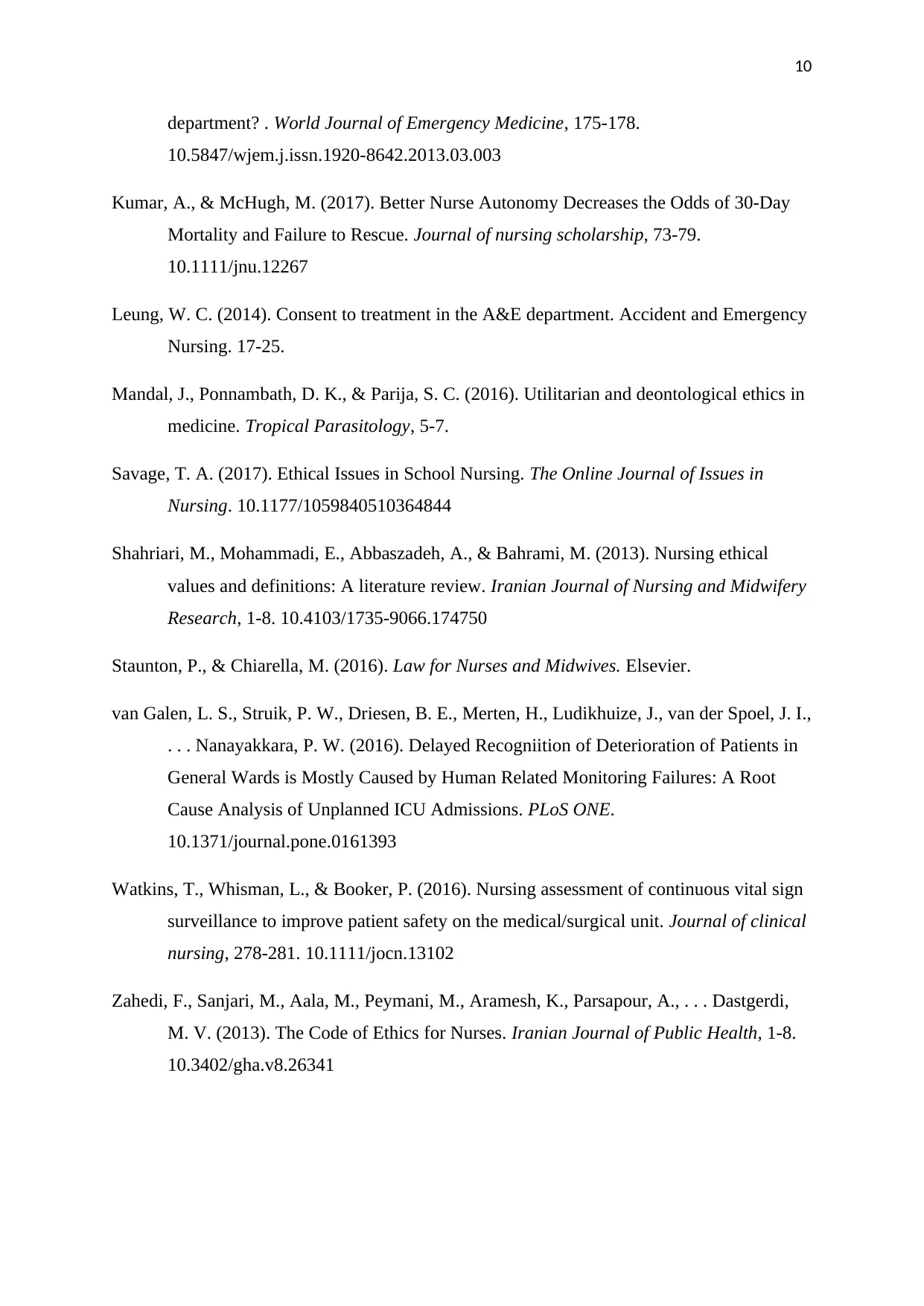
10
department? . World Journal of Emergency Medicine, 175-178.
10.5847/wjem.j.issn.1920-8642.2013.03.003
Kumar, A., & McHugh, M. (2017). Better Nurse Autonomy Decreases the Odds of 30-Day
Mortality and Failure to Rescue. Journal of nursing scholarship, 73-79.
10.1111/jnu.12267
Leung, W. C. (2014). Consent to treatment in the A&E department. Accident and Emergency
Nursing. 17-25.
Mandal, J., Ponnambath, D. K., & Parija, S. C. (2016). Utilitarian and deontological ethics in
medicine. Tropical Parasitology, 5-7.
Savage, T. A. (2017). Ethical Issues in School Nursing. The Online Journal of Issues in
Nursing. 10.1177/1059840510364844
Shahriari, M., Mohammadi, E., Abbaszadeh, A., & Bahrami, M. (2013). Nursing ethical
values and definitions: A literature review. Iranian Journal of Nursing and Midwifery
Research, 1-8. 10.4103/1735-9066.174750
Staunton, P., & Chiarella, M. (2016). Law for Nurses and Midwives. Elsevier.
van Galen, L. S., Struik, P. W., Driesen, B. E., Merten, H., Ludikhuize, J., van der Spoel, J. I.,
. . . Nanayakkara, P. W. (2016). Delayed Recogniition of Deterioration of Patients in
General Wards is Mostly Caused by Human Related Monitoring Failures: A Root
Cause Analysis of Unplanned ICU Admissions. PLoS ONE.
10.1371/journal.pone.0161393
Watkins, T., Whisman, L., & Booker, P. (2016). Nursing assessment of continuous vital sign
surveillance to improve patient safety on the medical/surgical unit. Journal of clinical
nursing, 278-281. 10.1111/jocn.13102
Zahedi, F., Sanjari, M., Aala, M., Peymani, M., Aramesh, K., Parsapour, A., . . . Dastgerdi,
M. V. (2013). The Code of Ethics for Nurses. Iranian Journal of Public Health, 1-8.
10.3402/gha.v8.26341
department? . World Journal of Emergency Medicine, 175-178.
10.5847/wjem.j.issn.1920-8642.2013.03.003
Kumar, A., & McHugh, M. (2017). Better Nurse Autonomy Decreases the Odds of 30-Day
Mortality and Failure to Rescue. Journal of nursing scholarship, 73-79.
10.1111/jnu.12267
Leung, W. C. (2014). Consent to treatment in the A&E department. Accident and Emergency
Nursing. 17-25.
Mandal, J., Ponnambath, D. K., & Parija, S. C. (2016). Utilitarian and deontological ethics in
medicine. Tropical Parasitology, 5-7.
Savage, T. A. (2017). Ethical Issues in School Nursing. The Online Journal of Issues in
Nursing. 10.1177/1059840510364844
Shahriari, M., Mohammadi, E., Abbaszadeh, A., & Bahrami, M. (2013). Nursing ethical
values and definitions: A literature review. Iranian Journal of Nursing and Midwifery
Research, 1-8. 10.4103/1735-9066.174750
Staunton, P., & Chiarella, M. (2016). Law for Nurses and Midwives. Elsevier.
van Galen, L. S., Struik, P. W., Driesen, B. E., Merten, H., Ludikhuize, J., van der Spoel, J. I.,
. . . Nanayakkara, P. W. (2016). Delayed Recogniition of Deterioration of Patients in
General Wards is Mostly Caused by Human Related Monitoring Failures: A Root
Cause Analysis of Unplanned ICU Admissions. PLoS ONE.
10.1371/journal.pone.0161393
Watkins, T., Whisman, L., & Booker, P. (2016). Nursing assessment of continuous vital sign
surveillance to improve patient safety on the medical/surgical unit. Journal of clinical
nursing, 278-281. 10.1111/jocn.13102
Zahedi, F., Sanjari, M., Aala, M., Peymani, M., Aramesh, K., Parsapour, A., . . . Dastgerdi,
M. V. (2013). The Code of Ethics for Nurses. Iranian Journal of Public Health, 1-8.
10.3402/gha.v8.26341
Paraphrase This Document
Need a fresh take? Get an instant paraphrase of this document with our AI Paraphraser

11
1 out of 11
Related Documents
Your All-in-One AI-Powered Toolkit for Academic Success.
+13062052269
info@desklib.com
Available 24*7 on WhatsApp / Email
![[object Object]](/_next/static/media/star-bottom.7253800d.svg)
Unlock your academic potential
Copyright © 2020–2026 A2Z Services. All Rights Reserved. Developed and managed by ZUCOL.





